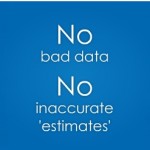 The industry knows the dirty little secret. Many third party listing websites are full of garbage data. In a major online marketing effort, REALTOR.com is telling this story.
The industry knows the dirty little secret. Many third party listing websites are full of garbage data. In a major online marketing effort, REALTOR.com is telling this story.
Inaccurate listings are not appearing here and there, but more than half the “for sale” listings on many sites populated from syndication are duplicates, already sold, expired, pending, or bank owned homes that are not for sale at all.
Bad real estate listing information is bad for the real estate industry. So many of these sites claim to be consumer centric, but they blatantly and knowingly allow data to be fed to their websites that is known to be suspect for accuracy. The consumer blames agents and brokers for inaccurate data, not the publisher. It soils the reputation of REALTORS. In truth, brokers and agents are not curating their listings on these sites, so they are in part to blame. But the publishers are to blame too. They make it nearly impossible to remove a listing.
As an industry, we know how to set policies for data accuracy. If that is a goal, it would be easy for third party sites to accomplish. Here is a very simple suggestion.  Require agents or brokers to confirm a property’s accuracy if nothing has changed in 30 days. Require the user to verify that the information is correct.
Require agents or brokers to confirm a property’s accuracy if nothing has changed in 30 days. Require the user to verify that the information is correct.
This is important for many reasons, not the least of which is integrity. Imagine the poor consumer who finds a home and wants to buy it. 50% of the time, they are likely to hear from a real estate agent that the home is not for sale. Oddly, some agents use this as a bait and switch ploy. Snag an actual buyer with “too good to be true” listings that are not real, and convert them to a buyer representation agreement. Sounds shady, but it is happening. It’s rare. What happens more often is the agent does not even respond to the consumer when they see the listing address.
If you care, run a search on a local broker or mls website. Then run the same search on a third party website. Look at the differences in listing count. Think about the consumer impression. A zip code search on a broker website may yield 100 results where it may yield 250 results on sites like Trulia or Zillow. The consumer impression is that Zillow and Trulia are abundant with listings that the local REALTOR does not know about – the secret gem in the rough. In truth, with FSBO listings and Make Me Move listings, that is sometimes the case. But more often than not, it is bad data.
I like third party listing websites as an online marketing tool for brokers. They work if the marketing plan is structured correctly. Enhancing is a must. Sending data without enhancing does not work unless you make changes to the MLS data. For example, truncating the data like listing photos to 4 is very effective. It encourages more clicks to the broker site where more detailed information has been curated for the consumer. If the broker site is good, the consumer sticks there.
If you want to add more than 4, add photos that talk about your brokerage – like a photo that has your logo, phone number and office contact information. Remember, you are advertising. This is really easy to do if you are a REALOGY brand as you can manually enter data into CREST. Keller Williams, RE/MAX and some other franchises may also have manual entry – I have not looked recently. Manual entry seems like a pain, but if you use images and descriptions to tell a compelling story that blends property information with agent and broker service information, you will attract consumers.
In a recent debate, a broker told me that it will simply aggravate consumers on third party websites if they do this. My response was “Great. If they don’t like it, they can visit your website where that information does not appear.”
The San Diego County MLS, Sandicor has also been innovative. They added a new property description field into the MLS specifically for syndication. This field is not governed by MLS rules and regulations that restrict marketing and other identifiable information of the agent or broker. As a result, REALTORS are entering their names, email addresses and phone numbers to generate the modern version of a Sign Call. This is a great strategy. If I were a broker, I would demand for my MLS to offer this field. If I were an MLS, I would have this on the agenda for the next MLS director or advisory meeting.
I have no idea how this issue will be fixed. Kudos to Trulia for their efforts on Direct Reference. It will clean the data. I only wish that Trulia would commit to removing all data that is not in the MLS Direct Reference feed. Kudos to Zillow too. If you are a broker that provides a feed directly to Zillow and enhances listings, they make a strong effort to block or remove other sources feeding duplicate listings. As I have said repeatedly, I like online marketing – but it is painfully broken.
I am hopeful that the .MLS, .BLC, SourceMLS, and/or MLS consumer facing websites emerge to solve the data accuracy issue for consumers too. There is a difference when data is derived from the MLS. It’s not perfect, but it is better. Perhaps NAR and local Associations will begin to promote using a REALTOR website along with using a REALTOR in their consumer marketing campaign. Yes, imagine that.
WAV Group publishes a lot about Listing Syndication. Click here for a list of articles that tell more of the story.
WAV Group supports brokers and MLSs with online marketing strategies and syndication strategies. Our next real estate conference will be NAR Midyear. If you are attending and want to talk about getting our help, call Victor Lund 805-709-6696 and we can schedule a discussion. 1000watt Consulting, Clareity Consulting, Pranix, Focus Forward, Larson/Sobodka also can help you out. Fixing this problem will take an industry-wide effort.






Leave A Comment